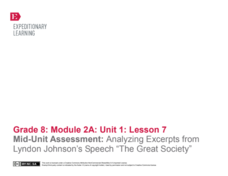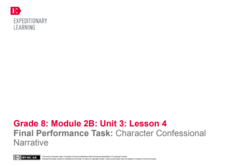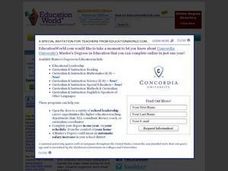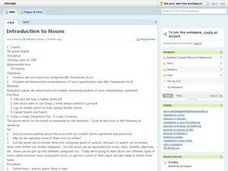EngageNY
Mid-Unit Assessment: Analyzing Excerpts from Lyndon Johnson’s Speech “The Great Society”
Time for intermission! Scholars take an intermission break from learning in the unit to work on a mid-unit assessment independently. Readers answer questions about Lyndon Johnson's Speech "The Great Society" to demonstrate the knowledge...
EngageNY
Adding to Cascading Consequences and Stakeholders: Industrial Food Chain
Young researchers create a class Cascading Consequences chart to see how the industrial food chain affects people, animals, and the environment. They also work in teams to complete a Stakeholders chart for the industrial food chain model...
EngageNY
Creating a Visual Component for the Speech: End of Unit Assessment Preparation and Practice
Eye contact, volume, pronunciation. Working with partners, scholars practice presenting their speeches about the best food chain. Additionally, they choose a visual component to support their end-of-unit speech.
EngageNY
Final Performance Task: Character Confessional Narrative
You wrote it, now what? Learners take their writing to the next level when they perform it for classmates. They then engage in a self-reflection and assessment of their work to determine how well they hit targets, such as identifying...
EngageNY
Performance Task: Write Ad Analysis
It's final. Scholars work on their final drafts of their ad analyses. They use the model sample Samsung Appliances for reference. After completing the task, learners turn and talk with one another about the decisions they made in...
EngageNY
Grade 12 ELA Module 1: Unit 1, Lesson 3
Using questions they developed, class groups discuss Chapter 2 of Malcolm X's autobiography, focusing on the individuals and events Malcolm X feels contributed to his character development.
Media Smarts
Unit Two: Celebrities and World Issues
Develop media smarts by considering the power of celebrity involvement in world issues. A look at the work of such celebrities as Angelina Jolie, Oprah, and Bono prepare learners to develop their own media campaign for a global...
Curated OER
Elements of Art
Third graders discover elements in visual art. In this visual art lesson, 3rd graders explore the use of line, shape, and color in visual art. After reviewing works of art, students create unique art pieces. Technology resources provided.
Curated OER
What Does Art Sound Like?
Help your charges investigate visual art by identifying sounds that are associated with the images. They view art galleries online and discuss which sounds would be present if the image was a real life situation. Additionally, they...
Curated OER
Comparing Works By The Same Author: Venn Diagram
A Venn diagram is a great tool. Middle schoolers research specific authors from different time periods, cultures, and genres. In groups, they create a Venn Diagram in order to compare and contrast two pieces of literature by the same...
Curated OER
"Painting" More Expressive Language
Young scholars listen to the book Papa, Please Get The Moon For Me, by Eric Carle. They create an illustration using a computer paint program. Learners type one sentence describing their picture into a text box in the paint program...
Curated OER
Printing and Publishing
Explore African literature and artwork in a multicultural literacy and art lesson. Begin with a read aloud of Tiger and the Big Wind: A Tale from Africa, and afterward, have kids retell the main events in the story. They...
Curated OER
Let's Talk About Painting
Discuss art and read Matthew's Dream. For this visual arts lesson, students recognize that there are different styles of art, each with its own techniques. Use simple techniques to understand art and work at stations to...
Curated OER
Working on the Slant
Compare and contrast a major news story from various newspapers. How does the perspective change? Are certain things included in some of the stories and left out of others? Have pupils complete a graphic organizer to compare how...
EngageNY
Launching Readers Theater Groups: Identifying Passages from Esperanza Rising for Readers Theater that Connect to the UDHR
Teach young readers how to compare two texts and select passages that exemplify a specific theme with Lesson 6 from Unit 3. Begin by modeling how an expert reader selects examples from a text, performing a think aloud on how Article 2 of...
PBS
Frankenstein: The Consequence of Creation
Famous as a horror story, as the first science fiction novel, Frankenstein is also a tale of ambition, a warning about unbridled science, and responsibility for actions. Readers consider what the tale says of the consequences of creation...
Novelinks
The Heart Is a Lonely Hunter: Vocabulary List
A staggering amount of work went into compiling this vocabulary resource for Carson McCullers' The Heart Is a Lonely Hunter. The overview provides a rationale for the strategy and information about tier 1, 2, and 3 words. The...
Robert Frost Farm
Socratic Seminar Format Overview
Whether new to the Socratic seminar format or an experienced veteran of the popular discussion technique, you'll find much to like in a five-page, richly detailed packet that not only details the prep necessary, the process, and the...
Curated OER
Language Arts: Introduction to Nouns
Ninth graders discover how to differentiate types of nouns through interactive group work by using packets of manipulatives and completing worksheets. After discussing the characteristics of common and proper nouns, they open the packets...
Curated OER
Snowy Similes
The class defines similes after creating a KWL chart about them. Groups rotate through a series of stations in which they creatively complete similes. They create a picture booklet that contains similes. However, the booklet topic and...
Southern Nevada Regional Professional Development Program
Vocabulary Activity
Talk about a menu! Who would have thought SAT prep could be so delicious? Treat your class to a full course of SAT words with a timed activity that asks groups to create clues for dishes on their bill of fare. Distained veggies anyone?...
Curated OER
Advocates for Disabilities
Students research people who have contributed to making life better for the disabled. For this advocacy lesson students enter the names of advocates on cards and divide into groups. Students complete a...
EngageNY
Interpreting, Integrating, and Sharing Information: Using Charts and Graphs about DDT
Is American growing fatter? Scholars begin with a mini lesson plan on reading charts and graphs using information about Human Body Fat in United States. They then transfer what they learned to charts and graphs using harmful and...
National Gallery of Canada
To Canada with Love
Focus on line and color with a postcard project. Learners view various works of art and discuss line and color before moving on to creating their own work. Using nature as inspiration, pupils decorate postcards and mail them after...

























